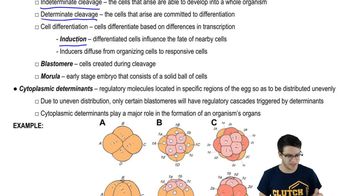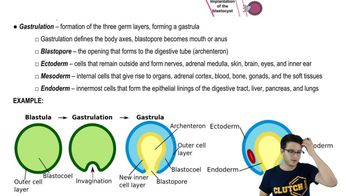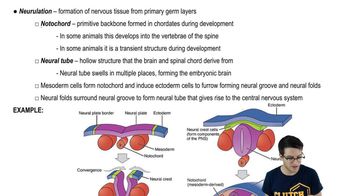Table of contents
- 1. Introduction to Biology2h 42m
- 2. Chemistry3h 40m
- 3. Water1h 26m
- 4. Biomolecules2h 23m
- 5. Cell Components2h 26m
- 6. The Membrane2h 31m
- 7. Energy and Metabolism2h 0m
- 8. Respiration2h 40m
- 9. Photosynthesis2h 49m
- 10. Cell Signaling59m
- 11. Cell Division2h 47m
- 12. Meiosis2h 0m
- 13. Mendelian Genetics4h 44m
- Introduction to Mendel's Experiments7m
- Genotype vs. Phenotype17m
- Punnett Squares13m
- Mendel's Experiments26m
- Mendel's Laws18m
- Monohybrid Crosses19m
- Test Crosses14m
- Dihybrid Crosses20m
- Punnett Square Probability26m
- Incomplete Dominance vs. Codominance20m
- Epistasis7m
- Non-Mendelian Genetics12m
- Pedigrees6m
- Autosomal Inheritance21m
- Sex-Linked Inheritance43m
- X-Inactivation9m
- 14. DNA Synthesis2h 27m
- 15. Gene Expression3h 20m
- 16. Regulation of Expression3h 31m
- Introduction to Regulation of Gene Expression13m
- Prokaryotic Gene Regulation via Operons27m
- The Lac Operon21m
- Glucose's Impact on Lac Operon25m
- The Trp Operon20m
- Review of the Lac Operon & Trp Operon11m
- Introduction to Eukaryotic Gene Regulation9m
- Eukaryotic Chromatin Modifications16m
- Eukaryotic Transcriptional Control22m
- Eukaryotic Post-Transcriptional Regulation28m
- Eukaryotic Post-Translational Regulation13m
- 17. Viruses37m
- 18. Biotechnology2h 58m
- 19. Genomics17m
- 20. Development1h 5m
- 21. Evolution3h 1m
- 22. Evolution of Populations3h 52m
- 23. Speciation1h 37m
- 24. History of Life on Earth2h 6m
- 25. Phylogeny2h 31m
- 26. Prokaryotes4h 59m
- 27. Protists1h 12m
- 28. Plants1h 22m
- 29. Fungi36m
- 30. Overview of Animals34m
- 31. Invertebrates1h 2m
- 32. Vertebrates50m
- 33. Plant Anatomy1h 3m
- 34. Vascular Plant Transport1h 2m
- 35. Soil37m
- 36. Plant Reproduction47m
- 37. Plant Sensation and Response1h 9m
- 38. Animal Form and Function1h 19m
- 39. Digestive System1h 10m
- 40. Circulatory System1h 57m
- 41. Immune System1h 12m
- 42. Osmoregulation and Excretion50m
- 43. Endocrine System1h 4m
- 44. Animal Reproduction1h 2m
- 45. Nervous System1h 55m
- 46. Sensory Systems46m
- 47. Muscle Systems23m
- 48. Ecology3h 11m
- Introduction to Ecology20m
- Biogeography14m
- Earth's Climate Patterns50m
- Introduction to Terrestrial Biomes10m
- Terrestrial Biomes: Near Equator13m
- Terrestrial Biomes: Temperate Regions10m
- Terrestrial Biomes: Northern Regions15m
- Introduction to Aquatic Biomes27m
- Freshwater Aquatic Biomes14m
- Marine Aquatic Biomes13m
- 49. Animal Behavior28m
- 50. Population Ecology3h 41m
- Introduction to Population Ecology28m
- Population Sampling Methods23m
- Life History12m
- Population Demography17m
- Factors Limiting Population Growth14m
- Introduction to Population Growth Models22m
- Linear Population Growth6m
- Exponential Population Growth29m
- Logistic Population Growth32m
- r/K Selection10m
- The Human Population22m
- 51. Community Ecology2h 46m
- Introduction to Community Ecology2m
- Introduction to Community Interactions9m
- Community Interactions: Competition (-/-)38m
- Community Interactions: Exploitation (+/-)23m
- Community Interactions: Mutualism (+/+) & Commensalism (+/0)9m
- Community Structure35m
- Community Dynamics26m
- Geographic Impact on Communities21m
- 52. Ecosystems2h 36m
- 53. Conservation Biology24m
20. Development
Animal Development
Problem 4`
Textbook Question
What structural adaptation in chickens allows them to lay their eggs in arid environments rather than in water?
a. Extraembryonic membranes
b. Yolk
c. Cleavage
d. Gastrulation
 Verified step by step guidance
Verified step by step guidance1
Understand the problem: The question is asking about a structural adaptation in chickens that allows them to lay eggs in arid environments, which means environments with little water.
Identify the key terms: The options provided are 'extraembryonic membranes', 'yolk', 'cleavage', and 'gastrulation'. Each of these terms relates to different aspects of egg development or embryonic development.
Explain 'extraembryonic membranes': These are membranes that form outside the embryo and are crucial for the development of amniotic eggs, which are adapted to terrestrial environments. They include the amnion, chorion, yolk sac, and allantois, which help in gas exchange, waste storage, and nutrient transfer.
Relate the adaptation to the environment: In arid environments, the ability to retain moisture and protect the embryo from desiccation is crucial. The extraembryonic membranes, particularly the amnion, create a protective, water-retaining environment for the developing embryo.
Conclude the reasoning: Based on the explanation, the structural adaptation that allows chickens to lay eggs in arid environments is the presence of extraembryonic membranes, as they provide the necessary protection and support for the embryo in a dry environment.
 Verified video answer for a similar problem:
Verified video answer for a similar problem:This video solution was recommended by our tutors as helpful for the problem above
Video duration:
1mPlay a video:
Was this helpful?
Key Concepts
Here are the essential concepts you must grasp in order to answer the question correctly.
Extraembryonic Membranes
Extraembryonic membranes are structures that develop outside the embryo in amniotes, including chickens, to provide protection and support. These membranes include the amnion, chorion, yolk sac, and allantois, which collectively facilitate gas exchange, waste removal, and nutrient transfer, allowing eggs to be laid in terrestrial environments without the need for water.
Recommended video:
Guided course

Biological Membranes
Yolk
The yolk is a nutrient-rich part of the egg that provides essential nourishment to the developing embryo. In chickens, the yolk contains proteins, fats, and vitamins necessary for growth, enabling the embryo to develop in a self-contained environment without external food sources, which is crucial for survival in arid conditions.
Recommended video:
Guided course

Overview of Animals - 1
Cleavage
Cleavage is the series of rapid cell divisions that occur immediately after fertilization, leading to the formation of a multicellular embryo. In chickens, cleavage is adapted to occur within the confines of the egg, allowing the embryo to develop efficiently in a terrestrial setting, independent of water-based environments.
Recommended video:
Guided course

Cleavage and Blastulation
Related Videos
Related Practice




























